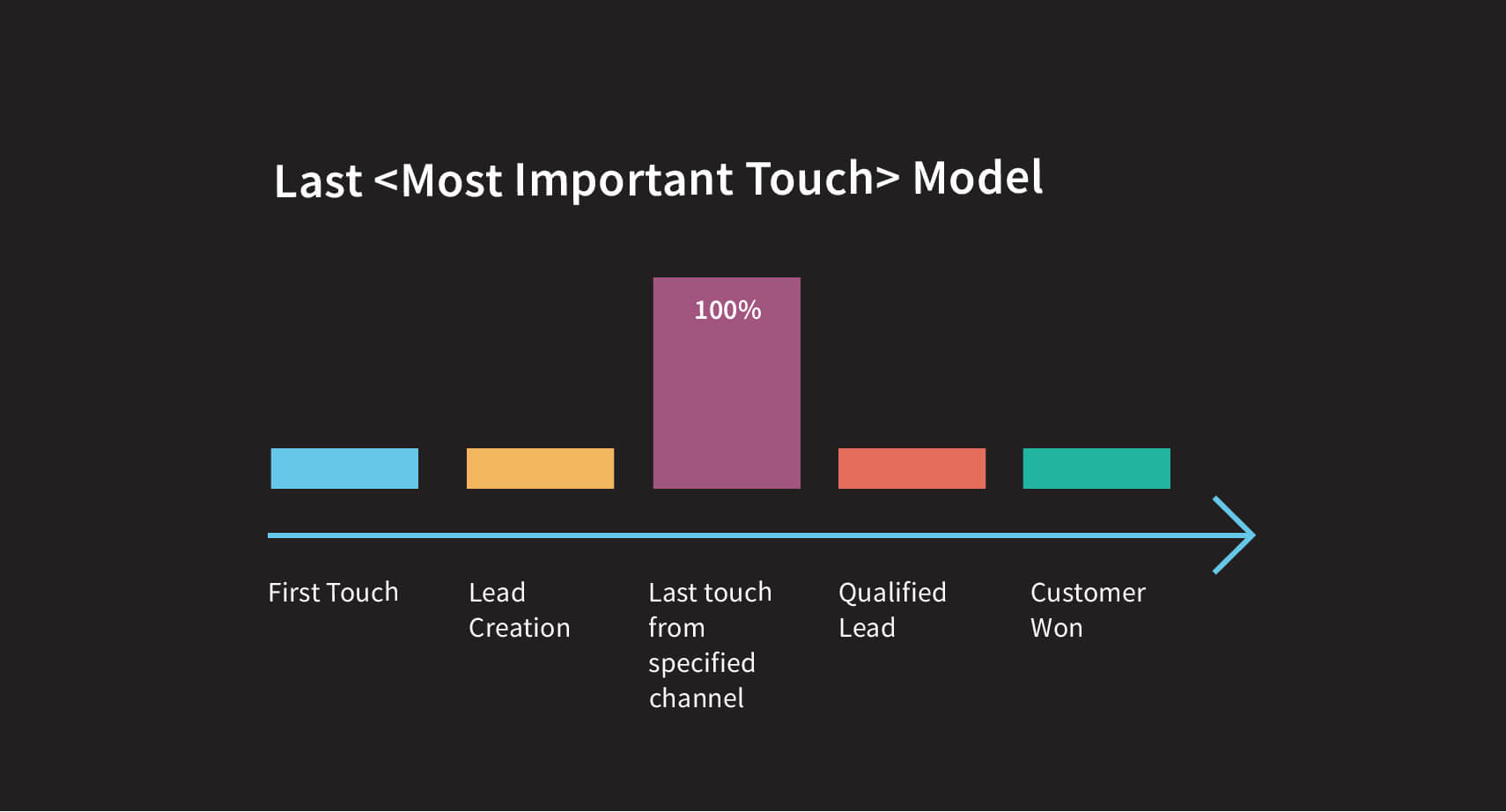Last < most important channel > touch models are customizable, single-touch marketing attribution models, but they’re a bit of an oddball when it comes to marketing attribution.
 Usually, marketing attribution models assess all your company’s different marketing channels and strategies with the aim of ranking them according to their level of importance. With last < most important channel > touch attribution, you’ve already decided which channel is most important - in other words, which one your attribution model is going to focus on.
Usually, marketing attribution models assess all your company’s different marketing channels and strategies with the aim of ranking them according to their level of importance. With last < most important channel > touch attribution, you’ve already decided which channel is most important - in other words, which one your attribution model is going to focus on.
We’re going to explore last < most important channel > touch attribution models in a bit more detail: why they’re useful, what some of the negatives are, and when you should consider using them.
- What’s a last < most important touch> attribution model?
- Pros of a last < most important touch> attribution model
- Cons of a last < most important touch> attribution model
- When to use this model and when to avoid it
What is a last < most important channel > touch attribution model?
Last < most important channel > touch attribution models give 100% of the credit for a sale to the last touchpoint of any one single pre-determined channel. This means that your reports will always show one channel as being wholly responsible for all of your sales.
Imagine that you work for a car rental company who’s decided to focus on how well their Google Ads campaigns are performing. A prospect Googles “car rental companies near me” and one of your ads is at the top of the list. They click through onto your website, browse around, call your office, and rent a car for their upcoming vacation.
In this instance, your attribution model would give 100% of the credit to the initial Google Ad, but it doesn’t stop there.
It’s not as simple as saying “this channel is responsible” - you might have multiple different campaigns running on any one channel. However, by adopting this attribution method and using the correct tags to differentiate between all your campaigns, you can then begin to sift through the ones that truly work and those that are having less of an impact.
In short, last < most important channel > touch attribution models adopt a very singular focus. They zone in on one single channel and let you then work out which of those channel’s strategies are actually working.
Pros of a last < most important channel > touch attribution model
- Simplicity
- Helps you optimize your most effective channel
- Allows you to look at specific campaigns in more depth
It goes without saying that last < most important channel > touch attribution models are fairly simple and easy to understand.
You know which channel you’re going to be focusing on, and you know which campaigns are running on this channel - the only thing you need to do is to see which of these is most effective and worth continuing to invest in. Therefore, this model is very useful if you want to optimize a channel that you already know works - and which you’re presumably spending a lot of money on.
Here at CallRail, we’ve found over time that we get the vast majority of our customers from paid search (like Google Ads and Microsoft Ads). Therefore, this is the channel which we pour the most investment into - and we use a last < most important channel > touch attribution model to assess each campaign’s effectiveness.
Cons of a last < most important channel > touch attribution model
- Only looks at one single channel
- Hard to optimize the rest of your marketing strategy if you never focus on how well it’s performing
- Self-limiting strategy to only attribute credit to the touchpoint that you’re investing in
Despite having some benefits to it, a last < most important channel > model falls short in a number of areas. It only looks at a single channel - regardless of what the customer journey looks like. It’s one thing to always decide to give credit to a single milestone (whether that’s the first touch, the last touch, or the lead-creation touch), but only focusing on one channel is highly restrictive.
You probably have multiple campaigns currently running across a number of different channels. If you’re spending money on these campaigns, then you need to know how well they're performing.
With a last < most important channel > touch model, you’ve already decided which channel will take all the credit. Sure, you don’t know which of its campaigns will come out on top, but it completely disregards your 360-marketing strategy in favor of one single channel.
Companies usually choose a variety of strategies across multiple channels when marketing their products - you want to cast a wide net so as to gain as many customers as possible.
By completely ignoring all but one of your strategies, you’re not setting your marketing campaign up for success. How do you know where to allocate your budget if you don’t even know what works and what doesn’t?
Plus, it’s not like one channel will consistently be the be-all and end-all of your marketing strategy. One channel might come out on top for a certain period of time, but when you make some tweaks to your other strategies, they suddenly end up surpassing it. In fact, there might be some instances where that channel doesn’t even appear in the customer journey.
At the end of the day, it’s a self-limiting strategy to only focus on the channel which you believe is most effective (or which received the bulk of your investment). Effective marketing attribution tells you which of your channels works best - it defeats the purpose if you set up your attribution model already thinking you know which channel this is.
To gain as many customers as possible, you need to try out every different method - and you need to be able to measure what works and what doesn’t.
When should you use a last < most important channel > touch model?
- If you already have plenty of customer data
- If you’re looking to optimize a single channel
- For short-term, in-depth analysis
There are some cases when using a last < most important channel > touch model can be quite useful. Despite its overall shortcomings, this model can work well for short periods of time if:
A) You’re a company that already has lots of historic customer data (and so know which of your marketing strategies consistently outperform the rest).
B) Are looking to analyze one specific channel with a view to optimizing it fully going forward.
Say you’ve been running a variety of marketing campaigns for a number of years now. You’ve tweaked investment, refreshed your copy multiple times, tried out lots of different platforms, and generally found that your display ads are consistently the highest performing method of acquiring new customers.
But there’s a problem.
Up until now, you’ve only been looking at display ads as one overall channel - so you don’t actually know which specific campaigns work best. You decide that you want to work out how to optimize display ads. After all, they’re already receiving the lion’s share of your investment and have consistently been the top-performing marketing strategy.
Your company is currently running 6 different sets of display ads - differing mainly in terms of their design and accompanying copy. You want to work out which is most successful, and if there are certain combinations of copy and design that work particularly well together.
First things first, you add some tags to help you differentiate between your display ads. You then let things run their course for a number of months - after all, you want a large sample size of customers before coming to any concrete conclusions.
The months pass and it becomes clear that ads matching colorful designs with short, pithy copy come out on top. But wait - these ads have all been running on Instagram, whereas the LinkedIn ads have been considerably more corporate and business-like. So you now decide to reverse the ads. After all, is it the ads themselves or the platform that is particularly successful?
Having run this experiment for another couple of months, it becomes clear - colorful, pithy ads consistently work better than more corporate ones, regardless of the platform. Armed with this knowledge, you now know to both invest heavily in display ads on all platforms, and to make sure that they always follow a certain design and copy brief. On occasions like this, last < most important channel > touch attribution models can help you fine-tune specific parts of your marketing strategy.
When should you avoid using a last < most important channel > touch model?
- If you’re just starting out
- If you have no idea of how well your marketing strategy is performing
- If you’re looking for overall, top-level insights
Companies who have just started out generally don’t know what works and what doesn’t. Sure, you might’ve come from a very similar industry and so have some prior knowledge, but this doesn’t mean that things will always follow the same pattern. Therefore, honing in on one particular channel doesn’t really make sense.
When you’re at the beginning of your journey, it’s important that you try out a variety of tactics to see which is most effective. Once you analyze the results, you can then begin to tweak - focusing your attribution on tried-and-tested methods.
There’s little point in deciding that one channel is going to be the key to your marketing strategy. Even if it is the most effective, that doesn’t mean that all others are worth scrapping, or that they don't need to also be optimized. Companies looking for generalized, top-level insights should avoid using a last < most important channel > touch model as it’s too restrictive in its focus.
Learn more about the different types of attribution models:
- First Touch Model
- Qualified Lead Model (Last Touch)
- Lead Creation Model
- Last Non Direct Click Attribution
- Last < most important touch > attribution model
- Linear Attribution
- Time Decay Attribution
- U-Shaped Attribution
- W-Shaped Attribution
- Z-Shaped Attribution












